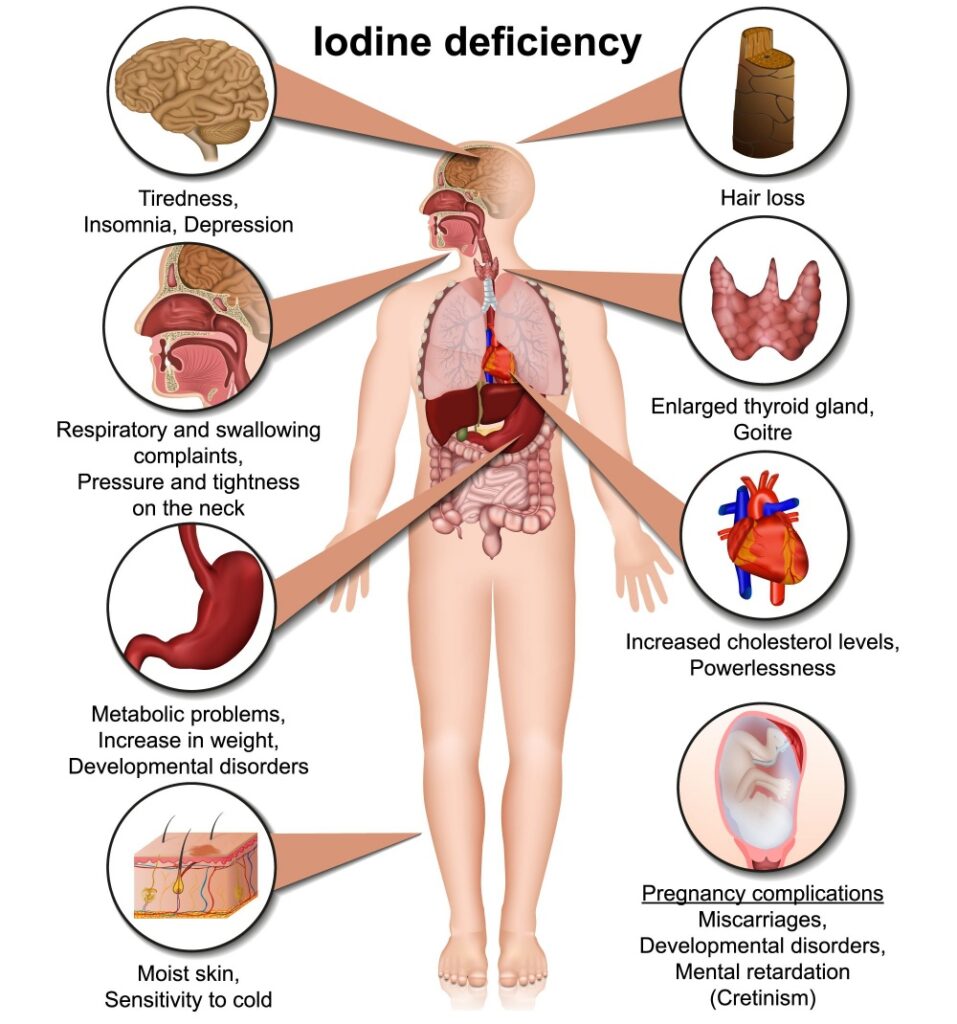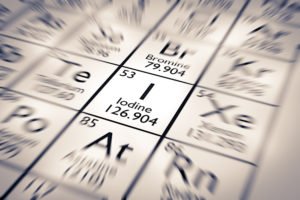What's On This Page?
ToggleEvaluating iodine levels can be tricky, and there are different types of iodine testing to consider. People with breast or prostate cancer/disorders as well as those with thyroid-related conditions should be testing for iodine deficiency.
You will likely want to multiple types of iodine testing to get an accurate picture. Today, I will guide you through an often-overlooked aspect of our health journey, iodine testing that could result in a more accurate diagnosis for you.
Diagnosis is EVERYTHING when it comes to getting well.

Iodine plays a pivotal role in our well-being, influencing everything from thyroid function, reproductive health, infection rates and even cognitive health. Iodine plays a positive role for certain malignancies.
Despite its importance, iodine deficiency remains a global health issue, affecting over 2 billion individuals worldwide, according to the World Health Organization.
People are afraid of iodine supplementation even though it’s just as important as its siblings like calcium, magnesium, potassium, iron, and others. But people are “iodophobic” a word I learned from my friend Dr. David Brownstein, who is an iodine expert. See below for information on him.
On the flip side, excessive iodine intake is not completely without risks, potentially leading to thyroid dysfunction and other health concerns. The same is true for iodine as it is for every mineral, balance is critical, too much or too little is harmful to your health. So iodine testing of your physiological levels is of interest to many people.
Navigating the balance of iodine can feel like walking a tightrope, but with the right knowledge and tools, you can achieve optimal iodine levels for your health. Here are some tests to accurately test for iodine deficiency or excess, ensuring that your thyroid and body operate at their best.
Signs of High vs. Low Iodine
Before diving into iodine testing, it’s crucial to recognize the signs of iodine imbalance. Iodine deficiency symptoms may include fatigue, confusion, trouble breathing, dry/scaly skin, weight gain, cold intolerance, and swelling of the thyroid gland. When the swelling gets really big, it’s called a goiter, and you may exhibit some symptoms – see below.
On the other hand, excess iodine, though less common, can manifest as hyperthyroidism and has symptoms that mimic an overactive thyroid (hyperthyroidism). Symptoms of excess iodine include a metallic taste, sore gums, burning mouth, sore throat, weight loss, stomach upset, palpitations, and anxiety.
Iodine testing varies from doctor to doctor. I’m going to list the 5 most important ways to test for iodine and of these, I recommend you do two tests just to confirm your status. I think doing two things on this list will give you the most accurate picture.

Iodine Testing: The Top 6 Tests Available Now
1. The Iodine Patch Test
The iodine patch test involves “painting” the skin with a small amount of Povidone Iodine to see how quickly it fades. One popular brand name of this iodine is Betadine®. It’s applied to the skin and then we observe how quickly it fades after a day.
While this test is easy to do at home, and it’s inexpensive, it’s less accurate and not scientifically validated. People do it at home all the time by themselves. But it should not replace more reliable measures but can serve as an initial screening tool. Many doctors dismiss this test, and that’s fine – I understand that because it’s a screening test. It doesn’t provide you (the patient) with a quantifiable number on a lab sheet.
2. Spot Urinary Iodine Testing
One simple and widely used method to assess iodine levels is a spot urinary iodine test. But it’s just a moment in time, so it isn’t that reliable. Urinary iodine concentrations can vary throughout the day, as well as from day to day. So spot urinary iodine concentrations are okay as part of a larger evaluation, but they are less reliable than a 24-hour urine catch. To summarize it, this test measures the amount of iodine excreted in the urine, providing a snapshot of iodine status. It’s a non-invasive and accessible test, reflecting recent iodine intake rather than long-term iodine status.
3. The 24-hour Urine Collection
The 24-hour urine collection is IMHO, the best diagnostic type of iodine testing that we have available today. It can gauge your iodine levels over a prolonged period. It’s used to assess the amount of iodine in a 24-hour period that your body spills out in the urine. This type of iodine testing does not tell us what intracellular levels are. We don’t have a way to test for that yet!
This 24-hour urine ‘catch’ test provides the most comprehensive picture of iodine intake and excretion in the human body. It offers insights into whether you might be experiencing iodine deficiency or excess. It’s easy. It involves collecting all urine excreted over a 24-hour period – you basically pee into a big jug!
Sometimes, the 24-hour urine test is collected following the ingestion of an iodine-containing substance (sometimes called a loading dose), but it can also be collected without any provocation and when they do it that way, they’re just trying to assess your iodine excretion over one day. Ask your doctor about the loading dose – it’s up to them. Either way, you’re still going to urinate into a big jug over 24 hours.
Certain precautions should be taken to ensure the accuracy of the results. For example, dietary and supplemental iodine can significantly influence the outcome of the test, so it’s important to manage these factors carefully, avoid foods rich in iodine and stop your supplements for about three days prior to beginning.

4. Serum Thyroglobulin (Tg) Test
Serum thyroglobulin is a protein produced by your thyroid gland and can be an indirect marker of iodine status. Elevated levels of Tg may indicate iodine deficiency. However, this blood test should be interpreted with caution, as factors other than iodine status can influence Tg levels. I heard you can now do this Tg test as a fingerprick ‘blood spot’ test but I am uncertain which lab(s) offer the fingerprick yet because it’s still kind of new. But you can get a regular blood test anywhere.
Other thyroid biomarkers like Total T3 and Total T4 may be reviewed too because remember, iodine is an essential element that is required for thyroid hormone production of thyroxine (T4) and triiodothyronine (T3). When doctors conduct iodine testing they should be comprehensive, so oftentimes, multiple tests are ordered. Go with it!
4. Iodine Blood Testing
The iodine test is a blood test that checks your iodine level and helps screen for iodine deficiency. A phlebotemist will draw blood from your vein at the local lab. This is a spot check done by blood but it’s not the most reliable since it’s just a moment in time. It’s a snapshot, like a Polaroid® picture – it’s not showing what your levels are over any time frame, just in that moment of time they drew the blood.
So it’s fine, it’s alright if you use this test, but it’s not the best in my opinion. Check with your own lab, however, this is likely the range you should be in for “normal” 40 – 92 mcg/L.

5. Physical Exams
While laboratory tests are the most reliable method for diagnosing nutrient deficiencies such as iodine, there are certain physical signs that you can check for. There are 3 tell-tale signs of iodine deficiency, and these correlate with hypothyroidism:
a) Goiter: One of the most direct physical signs of iodine deficiency is the enlargement of the thyroid gland, known as a goiter. The gland may become visibly swollen in the neck area as it tries to capture more iodine from the bloodstream.
b) Dry, Flaky Skin: Since iodine is involved in skin health, a deficiency might lead to dry, flaky skin.
c) Hair Loss: Iodine deficiency can sometimes lead to hair loss due to the role of thyroid hormones in hair follicle health.
If you have nodular thyroid disease, or goiters, or you have had a FNA (fine needle aspiration) for this condition, take 5 minutes to read my other article, Beyond the Biopsy: Revolutionizing Thyroid Nodule Evaluation.

Saliva Testing Coming Soon
Findings from this STUDY show that the amount of iodine in your saliva strongly matches the amount in urine, indicating that saliva can reliably reflect iodine status in the body. The results proved to be true across individuals with varying levels of dietary iodine intake. The study suggests that measuring iodine in saliva, especially when adjusted for protein or urea levels, could be a practical way to assess iodine levels in adults. Saliva iodine testing should be available very soon.
Foods to Avoid During Iodine Testing
- High-Iodine Foods: Seaweed (including kelp, nori, kombu), fish, sushi made with seaweed, shellfish, dairy products, and iodized salt are high in iodine and could skew the test results. It’s generally recommended to avoid these foods for a few days to a week before the test.
- Iodine-Containing Multivitamins and Supplements: Many multivitamins and specific supplements contain iodine. Consult with your healthcare provider about temporarily discontinuing these supplements before the test.
- Medications High in Iodine: Amiodarone is a cardiac rhythm drug that is high in iodine. It will raise the levels of your iodine. Read more about this problematic medication in THIS ARTICLE.

Supplements and Medications
- Iodine Supplements: Obviously, any iodine supplements should be avoided unless the test is specifically measuring supplementation levels.
- Certain Medications: Some medications, including amiodarone (a heart medication), some contrast dyes used in radiographic procedures, and certain topical antiseptics, contain significant amounts of iodine. Discuss with your doctor if (and when) you should pause the medication prior to iodine testing.

Considerations for Food
While avoiding high-iodine foods is advised prior to iodine testing, maintaining a balanced diet in the days leading up to your test is still important.
Focus on eating a variety of foods that are NOT on the high-iodine list, such as fruits, vegetables, protein, nuts and non-iodized salt. Otherwise your results will be skewed, and elevated.
What to Do on the Day of Your Test
Drink water as you normally would to avoid dehydration, which can concentrate your urine. Try to maintain your usual dietary and fluid intake habits during the 24-hour collection period unless advised otherwise by your healthcare provider. This helps ensure the test accurately reflects your typical iodine excretion levels.
As for food, fasting is NOT required for a spot iodine blood test, nor is fasting required for a 24-hour collection. So eat as you wish, avoiding the foods I’ve mentioned above that are iodine-rich.
It’s not a bad idea to check with your laboratory like Labcorp, Quest or wherever… because each laboratory (and doctors) have specific instructions based on the test’s requirements and your personal health situation. It’s crucial to follow any personalized advice given to you prior to conducting any iodine testing protocols. If you’re unsure about whether certain foods, supplements, or medications should be avoided before iodine testing.
We Have Iodine Receptors On Every Cell
One of the most fascinating aspects of iodine’s role in our body is its universal presence across all our cells. Each cell in our body is equipped with mechanisms to uptake iodine, showcasing the fundamental need for this micronutrient in our physiological processes. But how does iodine actually get into the cell?
Iodine enters the cells through a transport system known as the sodium/iodide symporter (NIS). This transporter is found in the cell membranes of many tissues, most notably in your thyroid gland but also in the breasts, salivary glands, and the gastric mucosa, among others. The NIS uses the gradient of sodium ions (which are more concentrated outside of cells than inside) to pull iodine into the cell against its concentration gradient.
This process requires energy and is critical for the synthesis of thyroid hormones and the proper functioning of cells and organs throughout the body.
Understanding the presence and function of iodine receptors across all cells underscores the importance of maintaining optimal iodine levels for the health of the entire body, not just the thyroid.
Summary
Iodine testing for deficiency or excess is a vital step in ensuring your thyroid gland functions efficiently, supporting your metabolism, energy levels, and much more. By considering my iodine testing tips, and all the different methods of testing, you should be able to get an accurate feel for your iodine levels. Many people are deficient, far more than suspected which explains the epidemic of hypothyroidism and increasing numbers of people with nodular thyroid disease and goiters.
Remember, whether you’re dealing with deficiency or excess, the goal is balance. Here’s to your health and finding that perfect equilibrium! For more information, please use my search box because I have many other articles archived here regarding thyroid-related disorders, iodine testing, and interpreting thyroid hormone lab results.
Respected Resource Reference
For those seeking further information on iodine testing and thyroid health, Dr. David Brownstein is a respected authority in the field. Here is his WEBSITE. With extensive research and clinical experience, Dr. Brownstein offers valuable insights into the importance of iodine, advocating for awareness and proper management of iodine levels to support thyroid and overall health.

Suzy Cohen, has been a licensed pharmacist for over 30 years and believes the best approach to chronic illness is a combination of natural medicine and conventional. She founded her own dietary supplement company specializing in custom-formulas, some of which have patents. With a special focus on functional medicine, thyroid health and drug nutrient depletion, Suzy is the author of several related books including Thyroid Healthy, Drug Muggers, Diabetes Without Drugs, and a nationally syndicated column.


